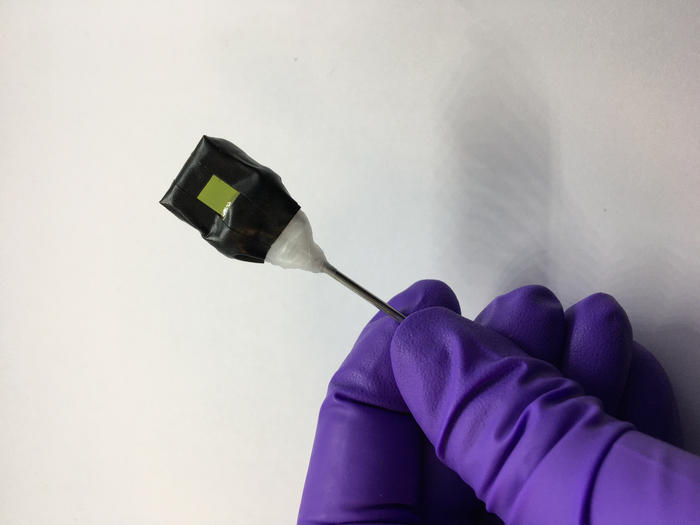Jun
06
2023
 Since we are in a “all hands on deck” situation when it comes to climate change, we need to take a look at all potential strategies for delaying and blunting global warming. The game at this point is all about peak warming – how much will the Earth warm before temperatures peak and then start to come down again (assuming we eventually drastically reduce our collective carbon footprint). This is not a win-lose, all-or-nothing scenario. It is very much a sliding scale – the higher peak warming is, the greater the chance of hitting some nasty tipping points and the greater the disruption to life and civilization.
Since we are in a “all hands on deck” situation when it comes to climate change, we need to take a look at all potential strategies for delaying and blunting global warming. The game at this point is all about peak warming – how much will the Earth warm before temperatures peak and then start to come down again (assuming we eventually drastically reduce our collective carbon footprint). This is not a win-lose, all-or-nothing scenario. It is very much a sliding scale – the higher peak warming is, the greater the chance of hitting some nasty tipping points and the greater the disruption to life and civilization.
Current evidence indicates that if we keep at 1.5 C warming or below (we are currently at 1 C warming) then we will probably be OK. If we exceed 2.5 C then there will very likely be disastrous results. Between 1.5 and 2.5 there is uncertainty. We don’t know precisely where the tipping points are (where will the Antarctic glaciers fail and essentially slide into the ocean), or exactly how bad things will get at each degree above 1.5. The problem is, we will almost certainly land somewhere between 1.5 and 2.5 C. So every bit we do to reduce that peak warming will likely have measurable benefits. For any intervention, therefore, the question is not whether or not it will prevent global warming, but rather how much will it likely reduce peak warming and lower the odds of the really bad stuff happening. This is why many experts believe we need an “all of the above” strategy. Every little bit helps.
With that in mind, what is the potential for reducing peak warming by maximizing living carbon sinks? Often this question is framed with respect to the most obvious living carbon sink – trees. Can we “prevent” global warming by planting a trillion trees, which should be framed as, how much does planting trees contribute to reducing peak warming. We can also frame it as, can we keep at or below a certain level (such as 1.5 C) if we plant enough trees?
Continue Reading »
Jun
05
2023
 We are still very much in the hype phase of the latest crop of artificial intelligence applications, specifically the large language models and so-called “transformers” like Chat GPT. Transformers are a deep learning model that use self-attention to differentially weight the importance of its input, including any recursive use of its own output. This process has been leverage with massive training data, basically the size of the internet. This has produced some amazing results, but as time goes by we are starting to see the real limits of this approach.
We are still very much in the hype phase of the latest crop of artificial intelligence applications, specifically the large language models and so-called “transformers” like Chat GPT. Transformers are a deep learning model that use self-attention to differentially weight the importance of its input, including any recursive use of its own output. This process has been leverage with massive training data, basically the size of the internet. This has produced some amazing results, but as time goes by we are starting to see the real limits of this approach.
I do see a tendency for a false dichotomy when it comes to AI – with AI is all hype at one end of the spectrum, to AI is going to save/destroy the world at the other. This partly follows the typical trend to overestimate short term technological process on the hype end, to underestimating long term progress on the cynical end. I think reality is somewhere in between – this latest crop of AI applications is extremely powerful, but has its limits and will not simply improve indefinitely.
I have been using several AI programs, like Chat GPT and Midjourney, extensively, and the limitations become more clear over time. The biggest limitation of these AI apps is that they cannot think the way people do. They mimic the output of thinking, without any true understanding. They do this by being training on a massive database, and using essentially statistics to predict what comes next (what word fragment or picture element). This produces some amazing results, and it’s still shocking that it works so well, but also creates interesting fails. In Midjourney, for example, (and AI art production application) when creating your prompts that result in image options, you can’t really explain to the application the way you would to a person what it is you want. You are trying to find the right triggers, but those triggers are quirky, and are highly dependent on the training data. Using different words to describe the same thing can trigger wildly different results, based upon how those words were used in the training data.
The same is true of Chat GPT. The more unusual your request the more quirky the result. And the results are not based strictly on reality, just statistically how words are used. This is why there is a problem with so-called hallucinations. You are getting a statistically probable answer, not a real answer, and quirks in the data will produce quirks in the result. The problem has no real understanding of what it’s saying. It’s literally just faking it, mimicking human language by statistically reconstructing what it has learned.
Continue Reading »
Jun
02
2023

What will be the ultimate fate of our universe? There are a number of theories and possibilities, but at present the most likely scenario seems to be that the universe will continue to expand, most mass will eventually find its way into a black hole, and those black holes will slowly evaporate into Hawking Radiation, resulting in what is called the “heat death” of the universe. Don’t worry, this will likely take 1.7×10106 years, so we got some time.
But what about objects, like stellar remnants, that are not black holes? Will the ultimate fate of the universe still contain some neutron stars and cold white dwarfs that managed to never get sucked up by a black hole? To answer this question we have to back up a bit and talk about Hawking Radiation.
Stephen Hawking famously proposed this idea in 1975 – he was asked if black holes have a temperature, and that sent him down another type of hole until Hawking Radiation popped out as the answer. But what is Hawking Radiation? The conventional answer is that the vacuum of space isn’t really nothing, it still contains the quantum fields that make up spacetime. Those quantum field do not have to have zero energy, and so occasionally virtual particles will pop into existence, always in pairs with opposite properties (like opposite charge and spin), and then they join back together, cancelling each other out. But at the event horizon of black holes, the distance at which light can just barely escape the black hole’s gravity, a virtual pair might occur where one particle gets sucked into the black hole and the other escapes. The escaping particle is Hawking Radiation. It carries away a little mass from the black hole, causing it to glow slightly and evaporate very slowly. This evaporation gets quicker as the black hole becomes less massive, until eventually it explodes in gamma radiation.
Continue Reading »
Jun
01
2023
 I did not plan to write yet another post about energy, but this popped up and I had to write about it. UMASS researchers have produced a device that generates electricity by harvesting charge from water vapor. They write:
I did not plan to write yet another post about energy, but this popped up and I had to write about it. UMASS researchers have produced a device that generates electricity by harvesting charge from water vapor. They write:
The common feature of these materials is that they are engineered with appropriate nanopores to allow air water to pass through and undergo dynamic adsorption–desorption exchange at the porous interface, resulting in surface charging. The top exposed interface experiences this dynamic interaction more than the bottom sealed interface in a thin-film device structure, yielding a spontaneous and sustained charging gradient for continuous electric output.
Mainstream reporting, which made national news, has been mediocre, although some better than others. Author Jun Yao states that the device is like an artificial cloud, but instead of building up a charge that gets released as lightening, it harvests a tiny amount of current. The key is not in the material itself, but its structure – which requires nanopores less than 100 nm wide. Obviously this is a proof-of-concept laboratory phenomenon. Yao claims this can be a source of large amounts of continuous clean energy.
I have lots of questions, and reporting so far has only touched on them. My first question is – how will this scale? Yao reports you could stack a billion such devices into an appliance the size of a refrigerator which could generate 1 kw of power. The average American home requires an average of 1.2 kw of power, but can draw 3-5 at peak demand. So we are in the ballpark with 1 kw. Assuming this all works and scales (a big assumption I am not willing to make) I can envision appliances perhaps the size of a mini-fridge, producing 200 watts power, which can be chained together to produce whatever power a particular building needs.
Continue Reading »
May
30
2023
 Starting around 1550 and lasting through the 1600s, England had an energy crisis. They were running out of wood, which was the main source of fuel for residential and commercial heating. England also needed a lot of wood for their massive navy – it took about 2,000 trees to build one of the larger warships. As a result they turned to coal, which has a high energy density and worked nicely for heating. It has the not-insignificant problem, however, of generating a lot of pollution, choking large cities like London in black smoke. This lasted into the 20th century, culminating with the great London smog of 1952.
Starting around 1550 and lasting through the 1600s, England had an energy crisis. They were running out of wood, which was the main source of fuel for residential and commercial heating. England also needed a lot of wood for their massive navy – it took about 2,000 trees to build one of the larger warships. As a result they turned to coal, which has a high energy density and worked nicely for heating. It has the not-insignificant problem, however, of generating a lot of pollution, choking large cities like London in black smoke. This lasted into the 20th century, culminating with the great London smog of 1952.
The world still burns a lot of coal to generate heat, but generally not in homes. There are other options, especially where people live. We can generate heat by burning cleaner sources of fuel, like natural gas. We can also generate heat through electrical resistance, producing no pollution directly (only in the production of electricity, which is likely remote from the user). Heat can also be harvested from waste heat and pumped into buildings. Or heat can be moved from one source to another using a heat pump.
Moving to more efficient and environmentally friendly methods of producing heat is at least as important to minimizing global warming as generating clean electricity. About half of world energy is used simply to generate heat, more than any other use (generating electricity is 20% and transportation is 30%). Decarbonizing heat production is therefore arguably more important than decarbonizing either electricity production or transportation, although of course they are all important.
Two technologies are likely to make the most difference in decarbonizing heat production. The first is harvesting waste heat from energy production and other industrial processes. This requires producing energy somewhat close to where the heat is needed, which is another advantage of more distributed rather than centralized energy production. Harvesting waste heat needs to be designed up front for any installation that will generate a lot of heat. Data centers, for example, expend a lot of energy just cooling all those computers. That heat can be put to good use.
Continue Reading »
May
19
2023
 When it comes to big problems it’s generally a good idea to remember some basic principles. One is that there is no free lunch. This is a cliche because it’s true. Another way to put this is – there are no solutions, only trade offs. Sometimes there is a genuine advance that does improve the calculus, and there are certainly more or less efficient ways to do things. But when making decisions that affect the technological infrastructure for a world-spanning civilization of billions of people, everything has consequences.
When it comes to big problems it’s generally a good idea to remember some basic principles. One is that there is no free lunch. This is a cliche because it’s true. Another way to put this is – there are no solutions, only trade offs. Sometimes there is a genuine advance that does improve the calculus, and there are certainly more or less efficient ways to do things. But when making decisions that affect the technological infrastructure for a world-spanning civilization of billions of people, everything has consequences.
As I have been writing about frequently, perhaps the biggest such decisions we face involve where we get the energy to power our civilization. On the one hand we have the technology of what’s possible. On the other we have economics, which will tend to favor the cheapest option regardless of other concerns. But then we also have – other concerns. That is generally where governments and regulations come in, ways for the public to exert their common interests other than making individual purchasing decisions. Free market forces are powerful at generating information and homeostatic systems, but are generally blind to long term or strategic planning. In my opinion, we need to have an optimal blend of both.
But in the background, science and technology is slowly, incrementally, advancing. We no longer have the luxury of just waiting for technology to solve our problems, but we do want to keep pushing the ball forward and make sure we include scientific progress in our strategic planning, and efficiently incorporate new technology when it’s available. That is partly why I like to peek a little ahead at potential technologies that might be coming down the pike.
Continue Reading »
May
18
2023
 There is an ongoing culture war, and not just in the US, over the content of childhood education, both public and private. This seems to be flaring up recently, but is never truly gone. Republicans in the US have recently escalated this war by banning over 500 books in several states (mostly Florida) because they contain “inappropriate” content. There are a few issues worth exploring here.
There is an ongoing culture war, and not just in the US, over the content of childhood education, both public and private. This seems to be flaring up recently, but is never truly gone. Republicans in the US have recently escalated this war by banning over 500 books in several states (mostly Florida) because they contain “inappropriate” content. There are a few issues worth exploring here.
First, I think it is an important premise to recognize the value of public education. As educator Dana Mitra summarizes:
Research shows that individuals who graduate and have access to quality education throughout primary and secondary school are more likely to find gainful employment, have stable families, and be active and productive citizens. They are also less likely to commit serious crimes, less likely to place high demands on the public health care system, and less likely to be enrolled in welfare assistance programs. A good education provides substantial benefits to individuals and, as individual benefits are aggregated throughout a community, creates broad social and economic benefits.
Continue Reading »
May
16
2023
 I have been writing blog posts and engaging in science communication long enough that I have a pretty good sense how much engagement I am going to get from a particular topic. Some topics are simply more divisive than others (although there is an unpredictable element from social media networks). I wish I could say that the more scientifically interesting topics garnered more attention and comments, but that is not the case. The overall pattern is that topics which have an ideological angle or affect people’s world-view inspire more passionate criticism or defense. Timed drug release is an important topic, with implications for potentially anyone who has to take medication at some point in their lives. But it doesn’t challenge anyone’s world view. ESP, on the other hand, is a fringe topic likely to directly affect no one, but apparently is 70 times more interesting to my readers (using comments as a measure).
I have been writing blog posts and engaging in science communication long enough that I have a pretty good sense how much engagement I am going to get from a particular topic. Some topics are simply more divisive than others (although there is an unpredictable element from social media networks). I wish I could say that the more scientifically interesting topics garnered more attention and comments, but that is not the case. The overall pattern is that topics which have an ideological angle or affect people’s world-view inspire more passionate criticism or defense. Timed drug release is an important topic, with implications for potentially anyone who has to take medication at some point in their lives. But it doesn’t challenge anyone’s world view. ESP, on the other hand, is a fringe topic likely to directly affect no one, but apparently is 70 times more interesting to my readers (using comments as a measure).
I also get e-mails, and my recent article on ESP research attracted a number of angry individuals who wanted to excoriate my closed minded “scientism”. I think people care so much about ESP and other psi and paranormal phenomena because it gets at the heart of their beliefs about reality – do we live in a purely naturalistic and mechanistic world, or do we live in a world where the supernatural exists? Further, in my experience while many people are happy to praise the virtue of faith (believing without knowing) in reality they desperately want there to be objective evidence for their beliefs. Meanwhile, I think it’s fair to say that a dedicated naturalist would find it “disturbing” (if I can paraphrase Darth Vader) if there really were convincing evidence that contradicts naturalism. Both sides have an out, as it were. Believers in a supernatural universe can always say that the supernatural by definition is not provable by science. One can only have faith. This is a rationalization that has the virtue of being true, if properly formulated and utilized. Naturalists can also say that if you have actual scientific evidence of an alleged paranormal phenomenon, then by definition it’s not paranormal. It just reflects a deeper reality and points in the direction of new science. Yeah!
Regardless of what you believe deep down about the ultimate nature of reality (and honestly, I couldn’t care less, as long as you don’t think you have the right to impose that view on others), the science is the science. Science follows methodological naturalism, and is agnostic toward the supernatural question. It operates within a framework of naturalism, but recognizes this is a construct, and does not require philosophical naturalism. So you can have your faith, just don’t mess with science.
Continue Reading »
May
15
2023
 Researchers recently published an extensive survey of almost 6,000 students across academic institution in Sweden. The results are not surprising, but they do give a snapshot of where we are with the recent introduction of large language model AIs.
Researchers recently published an extensive survey of almost 6,000 students across academic institution in Sweden. The results are not surprising, but they do give a snapshot of where we are with the recent introduction of large language model AIs.
Most students, 56%, reported that they use Chat GPT in their studies, and 35% regularly. More than half do not know if their school has guidelines on AI use in their classwork, and 62% believe that using a chatbot during an exam is cheating (so 38% do not think that). What this means is that most students are using AI for their classwork, but they don’t know what the rules are and are unclear on what would constitute cheating. Also, almost half of students think that using AI makes them more efficient learners, and many commented that they feel it has improved their own language and thinking skills.
So – is the use of AI in education a bane or a boon? Of course, asking students is only one window into this question. Educators have concerns about AI creating a lazy student, that can serve up good-enough answers to get by. There are also concerns about outright cheating, although that has to be carefully defined. Some teachers don’t know how to react when students turn in essays that appear to have been written by a chat bot. But many also think there is tremendous potential is using AI as an educational tool.
Clearly the availability of the latest generation of large language model AIs is a disruptive technology. Schools are now scrambling to deal with it, but I think they have no choice. Students are moving fast, and if schools don’t keep up they will miss an opportunity and fail to mitigate the potential downsides. What is clear is that AI has the potential to significantly change education. Simplistic solutions like just banning the use of AI is not going to work.
Continue Reading »
May
12
2023
 I recently recorded a YouTube video on the notion of hydrogen fuel cell cars (it will be posted soon, and I will add the link when it’s up). One question I did not get into in the video, but which is an interesting thought experiment, is hydrogen – plug-in battery hybrid vehicles. I can find just one model coming online in Australia, the Hyundai N Vision 74. This approach could, theoretically, save hydrogen from losing the the competition to replace internal combustion engine cars. I still don’t think so, but it’s an interesting idea.
I recently recorded a YouTube video on the notion of hydrogen fuel cell cars (it will be posted soon, and I will add the link when it’s up). One question I did not get into in the video, but which is an interesting thought experiment, is hydrogen – plug-in battery hybrid vehicles. I can find just one model coming online in Australia, the Hyundai N Vision 74. This approach could, theoretically, save hydrogen from losing the the competition to replace internal combustion engine cars. I still don’t think so, but it’s an interesting idea.
First let me state why I think battery electric vehicles (BEVs) are winning and will win this competition. BEV technology is already past the point where there is enough range for most users. While upfront costs are still higher than ICE vehicles, lifetime costs are lower. For those who own their own parking space, which will be the early adopters, there is an extreme convenience to charging at home. And – this is critical – battery technology is still improving, and quickly. There are already production batteries using silicone as the anode in lithium ion batteries with twice the energy density as existing BEV batteries (for now used in aircraft). They will likely go into production ground vehicles in a few years, and this same tech will likely double energy density again by the 2030s. BEVs have other advantages. They can be used for regenerative braking. There is already a reasonable infrastructure for recharging, and this is being built out fast. And, they are among the most efficient vehicles. The round-trip energy storage efficiency is >90%, and they are about twice as efficient in translating energy to the wheels as ICE vehicles.
The negatives for BEVs is the recharging time. Fast charging can take 15-20 minutes, although the newer batteries coming out in a few years claim 0-80% recharge in 10 minutes. In practice, I have not personally found this to be a problem. The only time I fast charge on the road is on long trips, and even a 15 or 20 minute recharge is basically a rest stop. Go to the bathroom, get some snacks or drinks for the ride, and your done. It does take a little planning, but software can do most of this for you. But sure, faster charging would be nice. The real negative for BEVs, in my opinion, is the raw material necessary to make them: lithium, cobalt, nickel, manganese and graphite (although the graphite will be replaced by silicone which is more abundant). Again, research is working on replacing the cobalt and nickel with more abundant elements, but for now this is a potential choke point.
Continue Reading »
 Since we are in a “all hands on deck” situation when it comes to climate change, we need to take a look at all potential strategies for delaying and blunting global warming. The game at this point is all about peak warming – how much will the Earth warm before temperatures peak and then start to come down again (assuming we eventually drastically reduce our collective carbon footprint). This is not a win-lose, all-or-nothing scenario. It is very much a sliding scale – the higher peak warming is, the greater the chance of hitting some nasty tipping points and the greater the disruption to life and civilization.
Since we are in a “all hands on deck” situation when it comes to climate change, we need to take a look at all potential strategies for delaying and blunting global warming. The game at this point is all about peak warming – how much will the Earth warm before temperatures peak and then start to come down again (assuming we eventually drastically reduce our collective carbon footprint). This is not a win-lose, all-or-nothing scenario. It is very much a sliding scale – the higher peak warming is, the greater the chance of hitting some nasty tipping points and the greater the disruption to life and civilization.
 We are still very much in the hype phase of the latest crop of artificial intelligence applications, specifically the large language models and so-called “transformers” like Chat GPT. Transformers are a deep learning model that use self-attention to differentially weight the importance of its input, including any recursive use of its own output. This process has been leverage with massive training data, basically the size of the internet. This has produced some amazing results, but as time goes by we are starting to see the real limits of this approach.
We are still very much in the hype phase of the latest crop of artificial intelligence applications, specifically the large language models and so-called “transformers” like Chat GPT. Transformers are a deep learning model that use self-attention to differentially weight the importance of its input, including any recursive use of its own output. This process has been leverage with massive training data, basically the size of the internet. This has produced some amazing results, but as time goes by we are starting to see the real limits of this approach.
 I did not plan to write yet another post about energy, but this popped up and I had to write about it.
I did not plan to write yet another post about energy, but this popped up and I had to write about it.  Starting around 1550 and lasting through the 1600s,
Starting around 1550 and lasting through the 1600s,  When it comes to big problems it’s generally a good idea to remember some basic principles. One is that there is no free lunch. This is a cliche because it’s true. Another way to put this is – there are no solutions, only trade offs. Sometimes there is a genuine advance that does improve the calculus, and there are certainly more or less efficient ways to do things. But when making decisions that affect the technological infrastructure for a world-spanning civilization of billions of people, everything has consequences.
When it comes to big problems it’s generally a good idea to remember some basic principles. One is that there is no free lunch. This is a cliche because it’s true. Another way to put this is – there are no solutions, only trade offs. Sometimes there is a genuine advance that does improve the calculus, and there are certainly more or less efficient ways to do things. But when making decisions that affect the technological infrastructure for a world-spanning civilization of billions of people, everything has consequences. There is an ongoing culture war, and not just in the US, over the content of childhood education, both public and private. This seems to be flaring up recently, but is never truly gone. Republicans in the US have recently escalated this war by banning over 500 books in several states (mostly Florida) because they contain “inappropriate” content. There are a few issues worth exploring here.
There is an ongoing culture war, and not just in the US, over the content of childhood education, both public and private. This seems to be flaring up recently, but is never truly gone. Republicans in the US have recently escalated this war by banning over 500 books in several states (mostly Florida) because they contain “inappropriate” content. There are a few issues worth exploring here. I have been writing blog posts and engaging in science communication long enough that I have a pretty good sense how much engagement I am going to get from a particular topic. Some topics are simply more divisive than others (although there is an unpredictable element from social media networks). I wish I could say that the more scientifically interesting topics garnered more attention and comments, but that is not the case. The overall pattern is that topics which have an ideological angle or affect people’s world-view inspire more passionate criticism or defense. Timed drug release is an important topic, with implications for potentially anyone who has to take medication at some point in their lives. But it doesn’t challenge anyone’s world view. ESP, on the other hand, is a fringe topic likely to directly affect no one, but apparently is 70 times more interesting to my readers (using comments as a measure).
I have been writing blog posts and engaging in science communication long enough that I have a pretty good sense how much engagement I am going to get from a particular topic. Some topics are simply more divisive than others (although there is an unpredictable element from social media networks). I wish I could say that the more scientifically interesting topics garnered more attention and comments, but that is not the case. The overall pattern is that topics which have an ideological angle or affect people’s world-view inspire more passionate criticism or defense. Timed drug release is an important topic, with implications for potentially anyone who has to take medication at some point in their lives. But it doesn’t challenge anyone’s world view. ESP, on the other hand, is a fringe topic likely to directly affect no one, but apparently is 70 times more interesting to my readers (using comments as a measure). Researchers recently published
Researchers recently published  I recently recorded a YouTube video on the notion of hydrogen fuel cell cars (it will be posted soon, and I will add the link when it’s up). One question I did not get into in the video, but which is an interesting thought experiment, is hydrogen – plug-in battery hybrid vehicles. I can find just one model coming online in Australia, the Hyundai N Vision 74. This approach could, theoretically, save hydrogen from losing the the competition to replace internal combustion engine cars. I still don’t think so, but it’s an interesting idea.
I recently recorded a YouTube video on the notion of hydrogen fuel cell cars (it will be posted soon, and I will add the link when it’s up). One question I did not get into in the video, but which is an interesting thought experiment, is hydrogen – plug-in battery hybrid vehicles. I can find just one model coming online in Australia, the Hyundai N Vision 74. This approach could, theoretically, save hydrogen from losing the the competition to replace internal combustion engine cars. I still don’t think so, but it’s an interesting idea.




